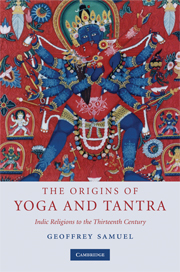Book contents
- Frontmatter
- Contents
- List of figures
- Preface
- 1 Introduction
- 2 Stories and sources
- PART ONE MEDITATION AND YOGA
- PART TWO TANTRA
- 9 The classical synthesis
- 10 Tantra and the wild goddesses
- 11 Subtle bodies, longevity and internal alchemy
- 12 Tantra and the state
- 13 The later history of yoga and Tantra
- 14 Postlude
- References
- Index
11 - Subtle bodies, longevity and internal alchemy
Published online by Cambridge University Press: 05 June 2012
- Frontmatter
- Contents
- List of figures
- Preface
- 1 Introduction
- 2 Stories and sources
- PART ONE MEDITATION AND YOGA
- PART TWO TANTRA
- 9 The classical synthesis
- 10 Tantra and the wild goddesses
- 11 Subtle bodies, longevity and internal alchemy
- 12 Tantra and the state
- 13 The later history of yoga and Tantra
- 14 Postlude
- References
- Index
Summary
As we have seen, a striking innovation in both Śaiva and Buddhist traditions in the course of the eighth to tenth centuries was a new series of yogic practices and techniques based on a subtle anatomy of the practitioner's body. Specifically, these practices assume an internal ‘subtle physiology’ of the body (or rather of the body-mind complex) made up of channels (nāḍī) through which substances of some kind flow, and points of intersection (cakra) at which these channels come together. The practices typically involve moving these substances through the body, clearing ‘knots’ in the flow, and directing the substances into a central channel flowing along the spine (Fig. 11.1). I refer to these practices, as do a number of other authors, as ‘subtle body’ practices (Samuel 2005b; White 1996). What I shall do in this chapter is to track this new pattern and explain how it developed.
A key element of the ‘subtle body’ practices is their close connection with sexual practices. Sexual intercourse, real or imagined, is used as a way to stimulate the flow of substances along and within the body, a process which is associated in various ways with meditative techniques for the attainment of health, long life and/or liberating insight. The subtle body practices thus provide a new and different purpose and significance for sexual practices within the Tantric context and increasingly take over from earlier views of sexual practice as being about initiation or feeding fierce female spirits.
- Type
- Chapter
- Information
- The Origins of Yoga and TantraIndic Religions to the Thirteenth Century, pp. 271 - 290Publisher: Cambridge University PressPrint publication year: 2008
- 1
- Cited by



